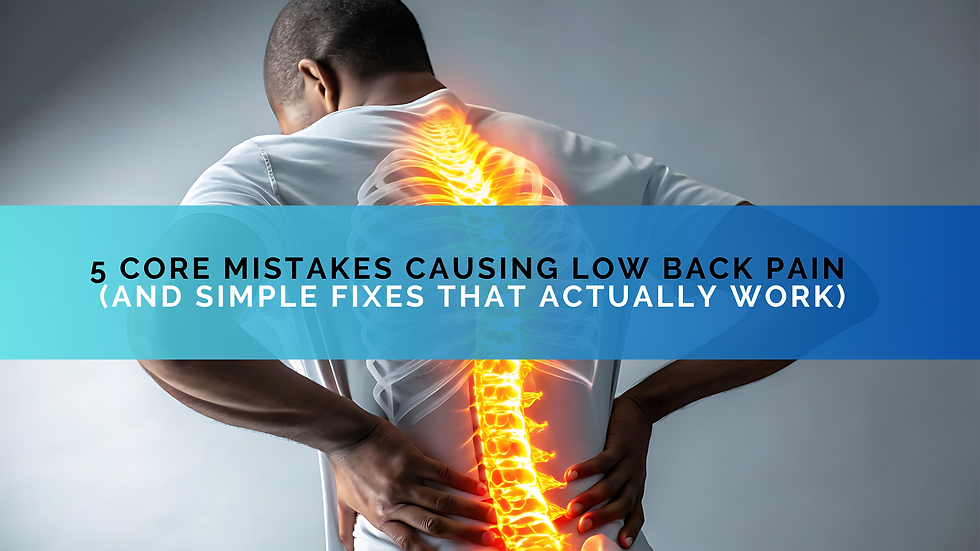The Best Exercises for Hormone Balance (Without Overtraining)
- Jennifer Walker CPT-SNS-LBS-CHC

- Jun 19
- 3 min read

How to Train Smarter for Sustainable Energy, Mood, and Results
If your workouts are leaving you exhausted instead of energized, or your body feels more inflamed than lean, it might not be your effort—it might be your hormones.
Hormones regulate everything from your energy levels to fat storage, recovery, mood, and even motivation. When they're off, no amount of hard training or clean eating will work the way you want it to.
The good news? The right training style can actually support hormone balance—instead of wrecking it.
Why Hormones Matter in Fitness
Your endocrine system (a.k.a. hormone central) controls how you feel, burn fat, build muscle, and recover. When you train too hard—or not in sync with your body—it can throw this system off.
Common signs your hormones are out of balance:
Trouble sleeping
Persistent belly fat despite training
Constant fatigue or burnout
Irregular cycles (for women)
Low motivation or depressive moods
Injuries that won’t heal
This is especially common in high-stress lifestyles, women over 30, and people doing too much HIIT or under-eating while training hard.
What Balanced Training Looks Like
To support your hormones, you don’t need to stop training—you just need to train smarter.
Here’s what that means:
1. Strength Training (2–4 Times per Week)
Builds muscle and supports insulin sensitivity
Improves natural testosterone and growth hormone
Boosts thyroid health and overall metabolism
Keep reps between 6–12, rest 1–2 minutes between sets, and avoid failure on every lift. The goal is progressive overload, not punishment.
2. Walk More Than You Run
Low-intensity movement such as walking, hiking, or cycling helps regulate cortisol, improves blood sugar response, and supports fat loss without stressing the body.
Aim for 7,000 to 10,000 steps per day or several longer walks per week.
3. Limit High-Intensity Workouts
High-intensity interval training (HIIT) has its benefits, but done too often, it can elevate cortisol and reduce recovery quality.
Limit HIIT to once per week, especially if you're already under stress. Circuit strength or moderate cardio is a better alternative.
4. Sync Your Training With Your Energy
Your body changes throughout the month, especially if you're female. Syncing your workouts with your natural energy fluctuations can reduce inflammation and improve results.
Examples:
Follicular phase (days after menstruation): Higher energy — lift heavier or push intensity
Luteal phase (before menstruation): More fatigue — focus on lighter resistance, mobility, and walking
5. Support Nervous System Recovery
Your nervous system plays a critical role in hormone balance. When it’s overstimulated, it signals the body to store fat, disrupt sleep, and reduce recovery.
Incorporate:
Deep breathing or parasympathetic activation (5–10 minutes)
Gentle cold exposure or contrast showers
Infrared sauna or Epsom salt baths
Gentle stretching or low-pressure yoga
Sample Week for Hormone-Supportive Training
Day | Focus |
Monday | Strength (Upper) |
Tuesday | Walk + Core + Breathwork |
Wednesday | Strength (Lower) |
Thursday | Mobility + Sauna/Walk |
Friday | Full Body Circuit |
Saturday | Low-Intensity Cardio |
Sunday | Recovery and Stretching |
Exercises for Hormone Balance
You don’t need to train harder—you need to train in sync with your body. Hormone-friendly training isn’t about slowing down; it’s about being intentional. The results? More energy, less burnout, better sleep, and a body that works with you—not against you.
Do you need help figuring your exercises for hormone balance or want a custom program built around your hormone health, lifestyle, and goals? I offer personalized training and recovery plans designed for real-life results. Send me a message and I can help build a plan for you.





Comments